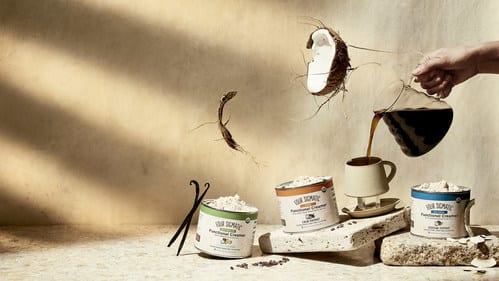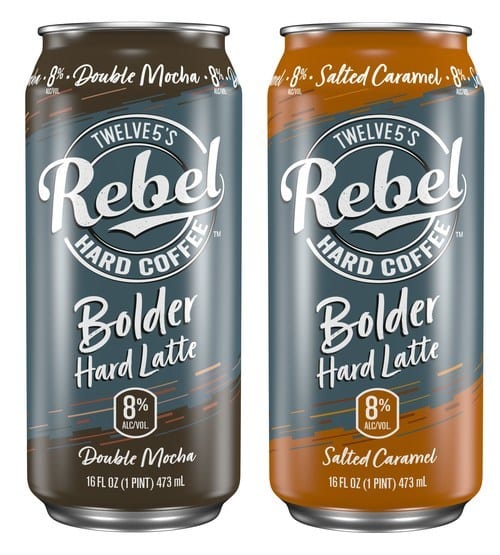Ingredient
Spotlight
Coffee flexes its muscles
By Lauren Sabetta
Hybridization, functionality spur growth for coffee ingredients
(Photo by priyampatel4 from Pixalaby/Image courtesy of Canva)
Originated from Darwinian evolutionary theory, the phrase “survival of the fittest” describes the mechanism of natural selection. The biological concept of “fitness” is defined as reproductive success. In Darwinian terms, the phrase is best understood as: “Survival of the form that will leave the most copies of itself in successive generations.” Whereas coffee drinks are experiencing a surge in popularity, experts are attributing its “fitness” to new exciting flavors and formulations.
According to Arnhem, Netherlands-based Innova Market Insights, global sales of coffee made up 64% of sales value for hot drinks in 2020, and new product launches for coffee drinks had a 17.1% compound annual growth rate from 2015-2019.
“If there’s any ingredient that could evade obscurity in the abyss of our beverage multiverse — it’s coffee,” says Philip Caputo, marketing and consumer insights manager at Virginia Dare, Brooklyn, N.Y. “Effortlessly adapting to the changing need-states, rituals and taste palates of an extensive fan base, coffee is suited-up for success.
“Innova Market Insights has even named ‘category collisions’ as trend drivers and coffee hybridization is a perfect example,” he explains. “Functional ingredients are paving the way for beverage innovation while coffee is both adapting and making inroads for functionals to follow.”
Four Sigmatic, the mushroom industry pioneer, launched a new line of coffee creamers: Think, Gut Health and Balance. The functional creamers deliver specific benefits from mushrooms, the company says. (Image courtesy of Four Sigmatic)

As demand is rising for specialty coffees, ethnic and exotic flavors, and coffees that are organic or processed with innovative methods, “hybridization is the weapon at play here,” Caputo says.
“At the speed of light roast comes wellness mashups like adaptogenic mushroom lattes and botanically infused cold-brew elixirs for all-day nutri-boosts,” he continues.
Meanwhile, the rapid proliferation of coffee drinks also has spurred new product development in coffee creamers, according to Virginia Dare’s “Flavors For The New Wave” white paper.
“Gone are the days when coffee creamer came only in plain and French vanilla” as creamers now are seen as a flavor delivery system for all sorts of functional ingredients, it says. Coffee creamers can deliver taste, texture, and aromatics to coffee, making them an ideal format for consumers looking for a particular sensory experience, it adds.
Recently, to complement its lineup of ground coffees made with mushroom adaptogens, Los Angeles-based Four Sigmatic launched a new line of coffee creamers: Think, Gut Health and Balance. The functional creamers deliver specific benefits from mushrooms, the company says. Each powdered variety is made with coconut milk, MCT oil, mushrooms, adaptogens, real vanilla, real cacao, and zero artificial flavors or fillers.
“If there’s any ingredient that could evade obscurity in the abyss of our beverage multiverse — it’s coffee. Effortlessly adapting to the changing need-states, rituals and taste palates of an extensive fan base, coffee is suited-up for success.”
— Philip Caputo, marketing and consumer insights manager at Virginia Dare Extract Co.
Adding to its “better-for-you” plant-based and organic creamers, Broomfield, Colo.-based Silk, recently expanded its creamer portfolio to include Silk Enhanced Almond Creamers and Silk Sweet Oat Latte Creamer. The Silk Enhanced Almond Creamers are available in two flavors: Vanilla Latte Almond Creamer and Salted Caramel Almond Creamer. The Silk Enhanced Almond Creamers contains 4 grams of protein in each 4-tablespoon serving, the company says.
Emerging trends and hybridizations
As the pandemic caused consumers to re-evaluate their health and wellness goals, paving the way for functional coffee drinks; “Thirty percent of coffee drinkers are interested in purchasing coffee with additional functional benefits,” according to Chicago-based Mintel’s “U.S. Coffee and RTD Coffee Market Report 2021.”
“The increased interest in premium coffee experiences suggests coffee and creamer brands should be bold with their product development,” it states. “It’s also time for brands to rethink coffee marketing, create marketing messages and develop [corporate social responsibility] (CSR) programs that reinforce consumers’ own sense of identity.
“Coffee brands will need to adapt to shifting consumer preferences and unstable market conditions,” it continues. “Gen Z’s preference for cold over hot coffee drinks will force coffee brands (particularly roasted coffee brands) to update their product development and marketing strategies.”

BOLDER is the latest addition to Twelve5’s Rebel Hard Coffee lineup that includes an 8% ABV in ready-to-drink (RTD) single-serve cans. (Image courtesy of Twelve5 Beverage Co.)
As cold-brew coffee has expanded into mainstream multi-outlets, the demand has led to a 339% sales growth in the last five years, according to Wauconda, Ill.-based Synergy Taste’s “100% Cold Brew Coffee Guide.” This trending interest is based on cold brew’s “smoother, less acidic taste and naturally sweeter, fruitier flavor,” the company says.
“Started in artisanal coffee shops, the cold-brew process soaks coarse ground beans in cold to room temperature water to make a traditional cold-brew coffee. The limiting factor with this process is the space, capital investment in equipment, and the time and energy required to soak large batches of beans to make only small amounts of finished cold-brew coffee,” it continues. “However, Synergy Flavors’ unique process not only meets the emerging standards of strict cold-brew coffee purists, but also allows for large scale manufacturing.”
As there is no standard identity for cold-brew coffee, formulators can increase its concentration by adding coffee powder, experts note.
London-based IWSR Drinks Market Analysis notes that cold brew also is making an appearance in a number of hybrid beverages that fall under the umbrella of hard cold brew.
“[M]any brands are tapping into the popularity of cold-brew coffee. Cold-brew coffee has seen U.S. sales and new product developments surge,” it states. “And while the nascent hard cold-brew category is much smaller, many brands are throwing their hat in the ring. Hard kombucha brand Kyla offers a Cold Brew Coffee variant, described as ‘a blend of roasty cold brew with creamy, light sweet vanilla undertones’ — this product is one of many following the hard kombucha trend flagged by IWSR.”
Expanding its product portfolio, Neenah, Wis.-based Twelve5 Beverage Co. launched two new Twelve5’s Rebel Hard Coffee innovations under its BOLDER platform. BOLDER is the latest addition to Twelve5’s Rebel Hard Coffee lineup that includes an 8% ABV in ready-to-drink (RTD) single-serve cans. Adding to the Hard Coffee lineup, the Double Mocha BOLDER Hard Latte is rich and smooth, while the Salted Caramel BOLDER Hard Latte is a blend of salty and sweet, the company says.
Taste, functionality continue to trend
As there have been seismic changes since the outbreak of COVID-19, “not all of those changes are negative,” noted Mintel’s Global Food and Drink Analyst Julia Büch, in a recent blog titled “3 Drink Trends To Watch-Out For In 2022.”
In fact, some trends have seen a stronger boost as a result of the pandemic and the recurrent social restrictions across Europe, according to Büch.
Whereas consumers have placed more priority on health ― spurring the demand for products supporting the immune system, equally in demand are special taste experiences, she explains.
“In Germany, over half of consumers say they are actively looking for new taste experiences, fueling the trend toward new beverage hybrids,” she stated. “A notable highlight emerging from the bar scene is Espressotini, a cocktail mix of espresso and vodka that is served in a martini glass. Another hyped drink is Proffee: consisting of coffee and protein shake, it’s particularly popular among young ‘gymfluencers.’”
As for taste trends in the United States, Virginia Dare foresees “more wellness flavors in coffee — those inspired by functional ingredients,” Caputo says. “Percolating from the dark roast side of the moon we have indulgent protein-stacked coffee smoothies, coffee-kissed colas/root beers, and grown-up chocolate milks bubbling with coffee profiles.
“For wellness flavor inspiration Virginia Dare has created taste collections such as Moodfluencing and Bodyboosting flavors,” he continues. “For example, an energizing crimson mocha latte (cold-brew coffee, oat milk, adaptogenic mushrooms, hibiscus tea, elderberry mocha flavor) or a restorative liquid gold latte (turmeric, oat milk, splash of cold brew, maple, and chai spice flavor).”
On the horizon, Virginia Dare expects more coffee-tea hybrids as consumers reach back in time toward holistic healing and traditional medicines, Caputo says. Carbonation, nitrogen and velvety oat milk still fuels interest in unique texture and flavor nuances, he adds.
“Classic and familiar flavors like mocha, vanilla and caramel are most in favor with consumers, so try a creative twist to lure both traditional and progressive coffee drinkers,” he says. “Virginia Dare’s Elevated Classic flavor approach achieves just that; honeycomb custard vanilla, spiced cardamom mocha, or caramel torched maple, for example.”
Sophisticated mashups are winners too, such as ice creams and sweet spices, melted mint chip mocha, caramel cone macchiato, and cinnamon chai snickerdoodle, Caputo notes.
“Humans take credit but don’t be fooled; Java the Hutt is behind the controls ensuring its own galactic survival. From its aromatic hypnosis that lures us toward a steaming beacon of hope, coffee will thrust even the most bitter-adverse beings to their knees screaming, bean me up,” he concludes. BI
